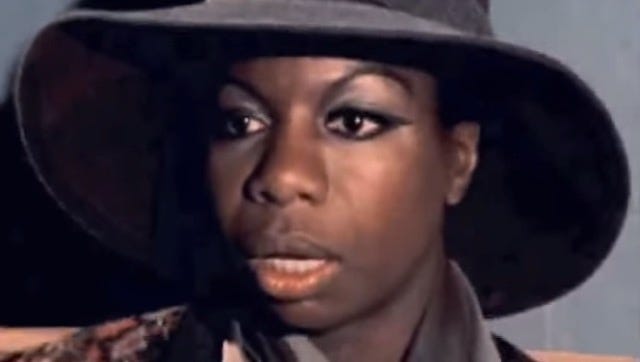History is not a fixed number; it’s variable.
The present is not infinite, and we have never thought it to be finite; it’s a variable.
If history is h and the present is p, we are always trying to solve for our personal place in the present. Let’s call that p3.
On a Sunday afternoon in September, I was looking for something on Netflix to watch while I meal prepped for the week. I saved several options, but I’m thankful that I opened the Nina Simone documentary1. I had always loved that Nina (Eunice Waymon) was this dark-skinned, deep-voiced, bold woman who cursed on stage before it was common. I don’t idolize vulgarity; I thrive on passion and conviction. It often is true that the tools of profanity and shock appeal are used to evoke the moods of passion and conviction.
As I watched her make magic on the stage, not just with her piano, but with her whole face and her whole body, I was moved into my state of inspiration.
Someone in the documentary called Miss Simone “the patron saint of the rebellion.” Dick Gregory said she, perhaps because she was a woman, said what none of the men, including himself, was brave enough to say with her song “Mississippi Goddamn.” Shortly after that segment, of course, they showed her singing “Strange Fruit.”
History, h, is a variable.
Students of history might say I don’t belong in their group because, to them, history is a fixed number. It’s a date on the calendar when something notable occurred. But I don’t always do well at memorizing dates. What I do well is synthesizing the what happened with the how it happened and the many variables of why. So, simplistically, I knew that segregation and Jim Crow forced Black people into proximity when they may not have been before. But complexly, I needed the images, the photo montage, the voices of Lisa Simone Kelly and two of the Shabazz daughters all in quick succession in order to see the sum (which of course is exponentially greater than the sum of its parts).
I have read Miss Simone’s quote - “An artist's duty, as far as I'm concerned, is to reflect the times” - more often than I can remember. It didn’t ever resonate with me until today. Not unlike my purpose being one thing, the pigeon-holing of artists into one duty made me uncomfortable. I also didn’t consider my work to be work that reflected the times. As I’ve been compiling old poems for a book, I recognize that, in fact, it always has been. So today, when I heard la Niña2 herself say that quote with her own mouth, wearing that cat eyeliner with that fabulous grey floppy hat, it clicked.
Good artists have a unique perspective on widely understood topics. They say, write, sing, dance, rhyme, and reason not only about the obscure, but about the common in a new or unprecedented way. It is my duty as aligned with my purpose to find the places where I can shine light on the obvious tensions.
The present, p, is a variable.
My personal place in the present, p3, is not a simple adding together of yesterdays. It’s also not an ignoring of both yesterday and tomorrow, so detached and present that I hover above it all. My p3 - and many people’s even though they have yet to see it - is h (history) plus or minus the amount that adults who raised us validated or denied history as a sum. And my duty as an artist is to talk about the ways that everyone in the present is validating or denying each variable present as a sum. I am meant to overstand the truth and graph it out so it’s clear and provable.
If my math metaphor doesn’t do it for you, what I’m saying is: all the history we don’t know or don’t teach is taking away our ability to understand our place in the world and to live it with purpose.
Are you living with purpose? If not, what variable are you treating as fixed? Is it history or the present?
I found out where she got her name by watching this documentary. She had a Latin boyfriend who called her Niña and she adopted it as a way to disguise her identity in the early days of her career.






